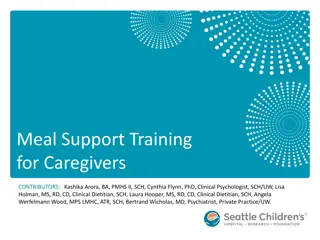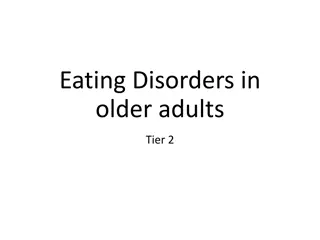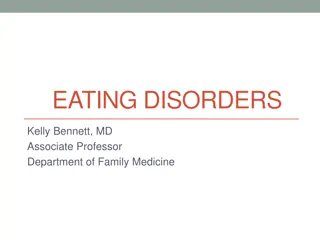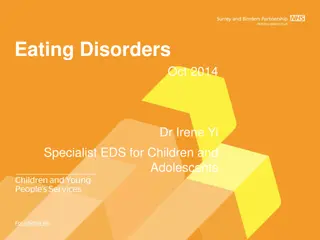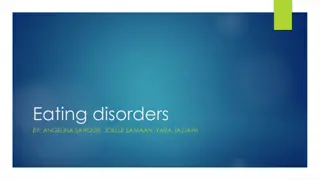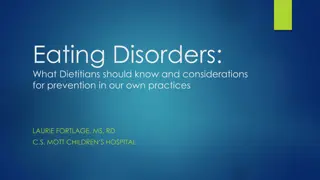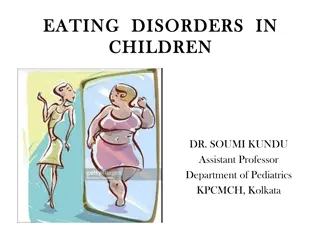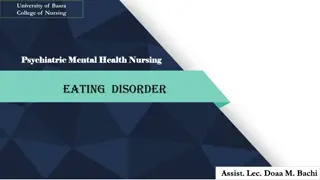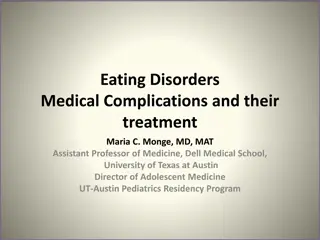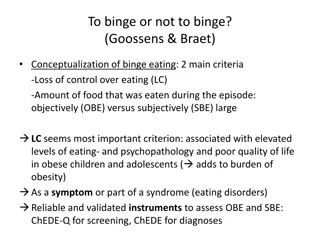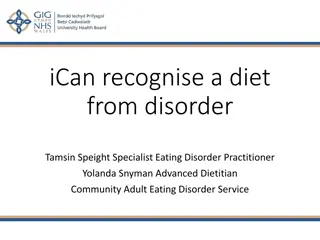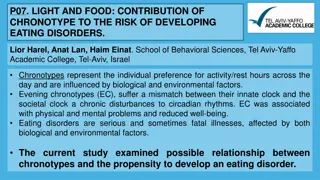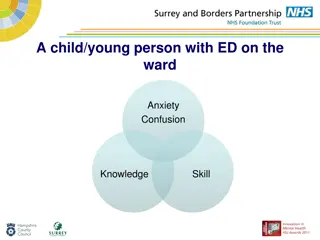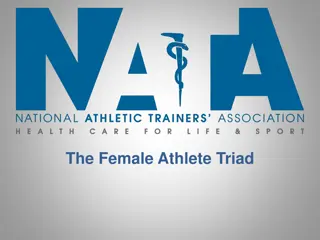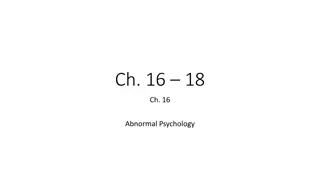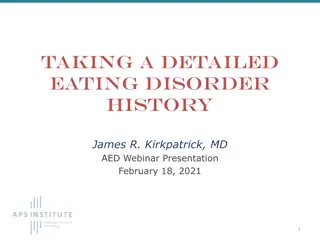Understanding Eating Disorders: Insights and Treatments
Body dissatisfaction is prevalent in both men and women, leading to the development of eating disorders like anorexia nervosa and bulimia nervosa. Anorexia nervosa is characterized by restricted food intake and intense fear of weight gain, while bulimia nervosa involves binge eating and purging behaviors. Treatment for anorexia includes stabilizing weight, cognitive behavioral therapy, and antidepressants. Bulimia symptoms include dental issues and recurrent binge eating episodes. Despite their seriousness, proper treatments and interventions can help individuals recover from these disorders and improve their quality of life.
Download Presentation

Please find below an Image/Link to download the presentation.
The content on the website is provided AS IS for your information and personal use only. It may not be sold, licensed, or shared on other websites without obtaining consent from the author. Download presentation by click this link. If you encounter any issues during the download, it is possible that the publisher has removed the file from their server.
E N D
Presentation Transcript
Eating Disorders Johnson County Health Department Jaycie Blanford
Body dissatisfaction 73% women and girls are dissatisfied with their bodies 56% of men and boys Society has an ideal body image that is tied to perfectionism and unrealistic expectations Single most powerful contributor to dieting and development of eating disorders
Eating Disorders Anorexia Nervosa Bulimia Nervosa Binge eating disorders
Anorexia Nervosa DSM-5 Symptoms Restricted net intake of nourishment that leads to significantly low body weight Physical symptoms Lowered metabolism Dehydration Anemia Intense fear of gaining weight Reduced blood pressure Disturbed body perception, undue influence of weight/shape on self- evaluation or persistent denial of seriousness of current low weight. Reduced body temperature Electrolyte imbalances that effects cardiovascular system Amenorrhea (no menstrual cycle) Damage to bones
Anorexia Nervosa Continued Types Prevalence 0.5-4% Binging/purging Less frequent than other eating disorders Individual takes in limited calories and follows with excessive exercise Tends to be female 90-95% Restricting types Age of onset is teen years shortly after pueberty Doesn t eat Limited portions Mortality rates Most deadly eating disorder 2-6% die from anorexia, but most recover
Treatments for Anorexia Nervosa Tube and intravenous feelings depending on severity Stabilizing weight before therapy can start Minimize dangerous eating behaviors by Cognitive Behavioral Therapy to tackle thoughts and changing behaviors Journaling is commonly used to record what an individual is eating and thinking Rewarding proper eating and restoring weight Antidepressants are used for some individuals Changing family interactions Educate Try to address some faulty communication patterns
Bulimia Nervosa DSM-5 Symptoms Physical symptoms Corrosion of dental enamel Recurrent episodes of eating excessive amounts of food (binge eating) Dehydration Recurrent inappropriate compensatory behaviors in order to prevent weight gain Irritation and enlargement of salvatory glands Continuing on average at least once a week for 3 months Amenia Undue influence of weight/shape self evaluation Menstrual irregularities Electrolyte imbalances
Bulimia Nervosa Continued Binges and Compensatory Behaviors Prevalence Consumption of 8,000-10,000 calories in one sitting 5% more common than anorexia Onset is late teens, early 20 s 30 binges a week Building sense of anxiety or tension that causes episodes that leads to binging being the only way an individual feels to cope More common in females (90-95%) Feelings of guilt after binge Vomiting (most common) Laxatives Exercising Once an individual forces themselves to purge, they only get rid of half the calories which makes body weight stay consistent and harder to diagnose
Treatment for Bulimia Nervosa Cognitive Behavior Therapy Journals are used to capture thoughts and feelings surrounding the urges Interpersonal Therapy Focused on relationships with others Determining if these relationships are causing disorders Short term psychodynamic therapy Coupled with family therapy Antidepressant medication Used in conjunction with therapy Aftermath It can last years if left untreated of individuals who enter therapy see improvement Never cured but can treat
Differences between Anorexia and Bulimia Sexual desires are more often in bulimia Individual with Anorexia has more impulse control Impulsive behavior Individuals with Bulimia have difficulty coping with daily stressors 1/3 of people with Bulimia could also be diagnosed with a personality disorder Borderline personality disorder
Binge Eating Disorder DSM-5 Symptoms Prevalence Recurrent binge eating episodes 2-7% of individuals Occurs at least once a week for 3 months No significant gender difference No pattern of inappropriate compensatory behavior commonly reflected as lack of control Not driven toward thinness Does not begin with extreme dieting Binge eating associated with 3 of the following: Rapid eating Eating large amount without physical hunger Eating until uncomfortably full Eating alone due to embarrassment Feeling of self-disgust, depression, or severe guilt
Treatments for Binge Eating Disorders Cognitive Behavior Therapy Antidepressants



